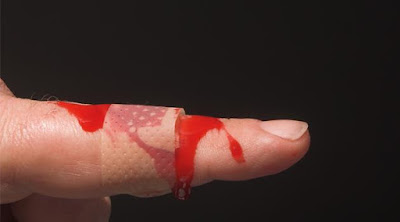What is hemophilia ?
Hemophilia or haemophilia is an inherited disorder of blood clotting. The blood does not clot properly because a certain coagulation factor in the blood is missing. There are two types of hemophilia. In hemophilia A, the patient has enough factor VIII; when there is too little is factor IX, we speak of hemophilia B. Hemophilia occurs almost exclusively in males, because the production of factor VIII and IX are regulated by a gene on the X-chromosome. Women can be merely a carrier of the disease. Only in very rare cases, hemophilia is also in women. If there is a shortage of one of the other coagulation factors, we are not talking about hemophilia but about another clotting problem. Hemophilia is a relatively rare disease, about 1 in 10,000 people have haemophilia. Hemophilia A is the most common (80%).
Description
In haemophilia, the patient remains on an injury or internal bleeding, bleeding for longer than people without hemophilia, even a relatively minor accident such as a slice or a nosebleed. Bruise or hematoma can be either the result of a not too severe trauma. It takes a long time in addition to a bruise in a person with hemophilia is gone. If this disease is left untreated, may result in anemia and haemophilia may indirectly even lead to death. Particularly harmful bleeding in the head and in the joints (especially ankles, knees, shoulders and hips). If they remain untreated, they can lead to permanent disability. The internal bleeding is very painful.
A common misconception about hemophilia is a slice though could lead to bleed to death. Admittedly, it can take days for a small wound in the skin is closed, which is quite awkward, but ultimately it will be blood clot without too much blood loss.
There are several distinct gradations severe hemophilia which already bleeding may occur spontaneously; moderate hemophilia with bleeding usually occur after a sharp rise and mild hemophilia with bleeding usually only occur after an accident or surgery.
Hemophilia symptoms
The symptoms of hemophilia A and B are dependent on the severity of the conditions and for both types is identical:
- Large bruises
- Bleeding into muscles and joints, especially the knees, elbows, and ankles
- Spontaneous bleeding (without apparent cause)
- Prolonged bleed some with injuries, dental work or surgery
- Serious internal bleeding into vital organs following a serious accident
- Brain Bleeding
What causes hemophilia ?
Haemophilia is in most cases caused by a mutation in a gene that encodes for one of the clotting factors. Hemophilia has a sex-linked recessive inheritance. Since the hemophilia gene is located on the X chromosome is the most common condition in men. The condition occurs in women to light only if both X chromosomes contain a mutated gene, or if during the embryonic period all healthy X chromosome are switched off: X-inactivation.
Hemophilia treatment
Hemophilia is now fairly easy to treat. The missing clotting factors are then regularly by injection administered so that bleeding. If bleeding occurs, it can be stopped with the same clotting factors. The treatment may entail many side effects such as the formation of antibodies. That makes treatment more difficult but not impossible in most cases. A good treatment hinges on the availability of the necessary clotting factors.
Hemophilia is a bleeding disease known for centuries. Only since 1964 is hemophilia with coagulants to treat. The most famous modern coagulants are Factor VIII and Factor IX. These proteins are isolated from human blood plasma by pharmaceutical companies or produced with recombinant DNA techniques. They all for that-temporarily-sufficient coagulant in the patient's blood is present, so that for example in an operation a normal clotting gradation can be achieved.
The treatment made from human blood coagulants has had disastrous consequences for some of the hemophilia population. In the eighties of the twentieth century coagulants made from human blood have been infected with the HIV virus. Thus, 17% of Dutch hemophiliacs infected hit. Many of them are deceased to the effects of AIDS. Along the same route of administration of coagulants (even before 1980), 66% of Dutch hemophiliacs infected with the hepatitis C virus. Plasma products are safe for HIV since 1985 and since 1992 for hepatitis C. Increasingly recombinant coagulation factor VIII products in use.
Operate in hemophilia patients can be tricky in that the body after a period of time can be immune to a coagulant. A relatively simple accident, including a broken hip after a fall, therefore all can be a challenge; Be sufficient coagulant is because it is administered to stop any internal bleeding, and the only question is whether the body more coagulant record for any subsequent operation.
Hemophilia research
Prof. Thierry VandenDriessche and Prof. Marinee Chuah of the Vrije Universiteit Brussel explore the possibilities of improved treatments for hemophilia, including the possibility of gene therapy. Both researchers failed in gene therapy as the first in a permanent cure of haemophilia A to bring about in mice. They succeeded in permanently cure through gene therapy in mice, but in tests on larger animals they ran into problems. A project wants the VUB research to elucidate the mechanisms responsible for the failure of gene therapy in hemophilia patients.
History of hemophilia
In several European royal families come for hemophilia. Queen Victoria of England wore (recessive) allele to her son Leopold and two of her daughters, Alice and Beatrice. Alice carried the gene through her daughter Alexandra, later tsarina of Russia, to her grandson about the Tsarevitch Aleksej. He was perhaps the most famous hemophilia patient. To heal his illness switched his parents, Nicholas II of Russia and Alexandra Feodorovna, the faith healer Rasputin in. Via Beatrice got the disease in the Spanish royal visit. At the moment there are no members of European royal houses familiar with hemophilia.

